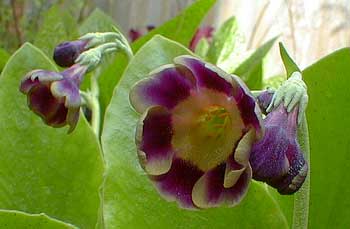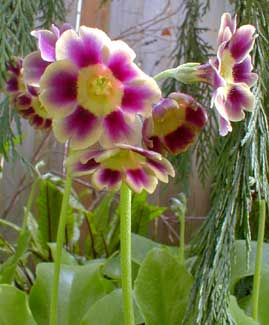
Mountain Cowslip; aka,
Bear's Ears; aka,
Border Garden Auricula
"Hither, hither, sweet
'Tis a cowslip bed
Hither, hither, sweet!
'Tis with dew bespread!"
-John Keats
Primula auricula or Mountain Cowslip has such beautiful blossoms beginning in early April, with later reblooms to be expected at least through June. It is shown here in two consecutive Aprils, 2003 & 2004. The petals are dark purple on the outside with blushes of gold at the edges, with the inner petals purple with golden centers.
Although this was sold to us as a species-primrose, the leaves got much bigger than the species, & when it bloomed, it was not the pure yellow of the species. It was obviously a "garden auricula," meaning unnamed intraspecies color hybrids such as have been grown in European gardens for centuries, the earliest printed mention of larger gardened forms being in 1582. They were in particular a fad during the Victorian age, with many colors developed, though among the basic colors are purple or blue-purple with yellow or ivory eyes.
 There are hundreds of varieties of auriculas divided into four categories & sundry sub-categories, with many colors in each camp. Ours is a Gold-centered Border Auricula. The other categories are Alpine Auriculas, Show Auriculas, & Double Auriculas, but as we don't grow the fanciest types, I won't define them. Those are often grown in cold frames or under glass or in alpine houses, in order to preserve their finer qualities, for they are easily damaged by the weather. But the Border Auriculas are spectacularly garden-hardy & not damaged by exposurure to wind & rain. They are all easily grown, but the Border Auriculas are the hardiest of hardies & the only category generally recommended for unprotected outdoor cultivation.
There are hundreds of varieties of auriculas divided into four categories & sundry sub-categories, with many colors in each camp. Ours is a Gold-centered Border Auricula. The other categories are Alpine Auriculas, Show Auriculas, & Double Auriculas, but as we don't grow the fanciest types, I won't define them. Those are often grown in cold frames or under glass or in alpine houses, in order to preserve their finer qualities, for they are easily damaged by the weather. But the Border Auriculas are spectacularly garden-hardy & not damaged by exposurure to wind & rain. They are all easily grown, but the Border Auriculas are the hardiest of hardies & the only category generally recommended for unprotected outdoor cultivation.Surprisingly enough we didn't select this one for the fine two-colored blooms, for we obtained it in winter before it flowered. We liked it for the leaves, & it was chosen just on the strength of the strongly evergreen & nearly succulent foliage held in slovenly rosettes on thick tough stolons. It looked like something that sincerely belonged in the woodland garden.
These big leaves are the opposite of delicate & not what most people think of as primrose leaves, unless they know auriculas in particular. The second-most common name, Bear's Ears, reflects this toughness of appearance.
When Granny Artemis first pointed it out in the nursery, we could see at once it would be a fine addition to a garden of low-growing leafy plants, with a four-season presence. We planted it among other evergreen & semi-evergreen primroses, where it is the only one with pale smooth leaves, the others being soft, crinkled & dark. It was good luck rather than careful choice that also gave us those spiffy yellow-eyed purple blossoms.
The species is native of the Alps, Apennines, & Carpathian Mountains. The conditions it enjoys are common to the majority of primroses: neutral to slightly acidic moist humousy, in sun or partial shade, but with perfect drainage even more than commonly necessary as the thick stoloniferous roots are subject to rot in damp conditions. Ours primroses are on a humpy little hill with fine drainage & regular watering.
A bit of fertilizer early in spring is sufficient, if even that; it is practically care-free. When the clump is overlarge after a few years it can be divided in early spring.